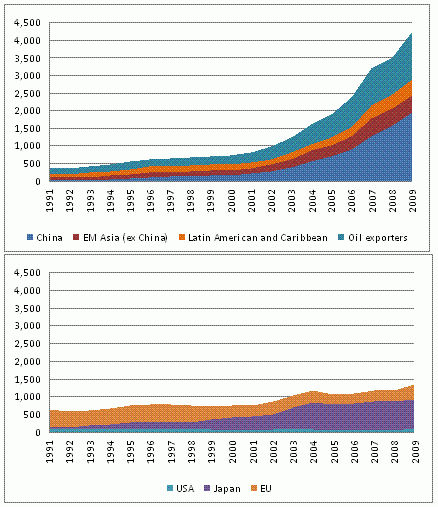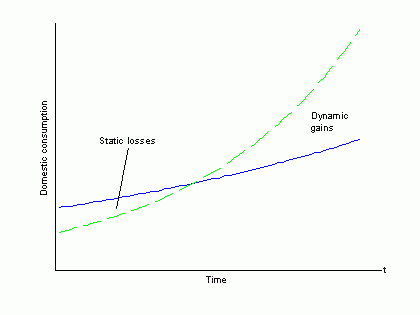The last ten years have seen reserve holdings of emerging countries increase more than fivefold. By April 2010 China alone held a bigger stock of foreign reserves than all industrial countries combined – $2.4 trillion, or half of its GDP. But China is not an isolated case. The rest of emerging Asia has also dramatically increased its reserve holdings (Figure 1).
Figure 1. Foreign exchange reserves of industrial and emerging countries (billions of constant 2000 US$)
Source: World Bank World Development Indicators
Why reserve hoarding by emerging markets?
These facts run counter the logic of conventional open-economy growth models, in which countries with rapid productivity growth are predicted to run current-account deficits so as to accelerate the build-up of their domestic capital stock. The literature has offered two different explanations for this seeming contradiction.
- The first views reserve accumulation as a form of precautionary savings to insure against future adverse shocks (see e.g., Aizenmann and Marion 2003, Durdu et al. 2009, Mendoza et al. 2009, and Carroll and Jeanne 2009).
While there is certainly some truth in this view, it is not clear if this desire to insure against shocks of realistic magnitude is enough to generate the massive volume of reserves currently held by emerging markets.
- The second explanation attributes much of Emerging Asia’s reserve accumulation to a “neo-mercantilist” development strategy that aims to promote economic growth by expanding exports.
This has been argued, for example, by Dooley et al. (2003) and Rodrik (2009). Mercantilism was a widespread economic doctrine in Europe during from the sixteenth to the mid-eighteenth century. It held that nations would prosper by encouraging exports and limiting imports – or, in modern terms, by achieving a surplus in their trade balance.
One modern-day rationale commonly offered for such a strategy is the presence of positive externalities, such as learning-by-doing effects, arising from export (or, more broadly, tradable) industries. As a result, the economy’s decentralised equilibrium in the absence of policy intervention features a sub-optimally low production of tradables. A policy that expands the output of tradable industries can then lead to welfare gains.
One way to expand the output of the tradable sector is by undervaluing the real exchange rate through foreign reserve accumulation – i.e., by increasing the price of tradables in terms of nontradables. With a closed (or closely managed) capital account, reserve hoarding effectively amounts to removing tradable goods from the domestic economy, making them relatively scarcer and raising their relative price. This in turn raises the profitability of tradable goods and encourages their production, triggering the desired learning-by-doing effects.
But why resort to this roundabout way of subsidising tradables? The textbook recipe of government subsidies targeted directly at the production of tradable goods seems a much simpler option to induce agents to internalise these externalities.
Reserve hoarding as a targeting device
In reality, policymakers rarely have access to textbook-style targeted subsidies (or taxes).
- Real-life selective subsidies pose severe agency problems, as they create ample opportunities for rent extraction – even in economies with highly developed institutions (see articles on the EU Common Agricultural Policy in the New York Times 2009a and 2009b).
- Effective sector-specific targeting often imposes unrealistic knowledge requirements on policymakers.
In practice, governments have limited information, and may have a hard time distinguishing between productive and unproductive activities. Even a well-meaning policymaker that attempts to promote specific industries may end up inefficiently steering the country away from its comparative advantage (see Klimenko 2004).
WTO objections
In addition to these general targeting problems, long emphasised in the economics literature, tax-cum-subsidy interventions with neo-mercantilist objectives face another type of hurdle: multilateral agreements, such as those governing the WTO, curtail the ability of countries to deploy sector-specific taxes and subsidies. Any such actions that directly or indirectly lead to expanding exports are by design subject to multilateral restrictions on “trade-distorting interventions” (see Charlton and Stiglitz 2006 and UNCTAD 2006).
Under such conditions, reserve accumulation provides an indirect targeting mechanism that overcomes these hurdles (Korinek and Servén 2010). In effect, accumulating reserves – i.e., granting credit to foreigners to finance exports of domestic tradable goods – allows the government to “outsource” the targeting problem to foreigners.
Does neo-mercantilist reserve hoarding raise welfare?
Undervaluation through reserve hoarding generally raises tradable output relative to non-tradable output. But does it pay off – does welfare increase? Through the associated learning-by-doing externalities, it may increase future productivity and growth, which produces dynamic welfare gains. But reserve accumulation also comes at the expense of reduced domestic consumption or investment of tradable goods, which involves a static resource loss to the economy in every period that the policy is enacted. The net welfare effect of neo-mercantilist reserve accumulation depends on the trade-off between this static welfare loss and the dynamic gains arising from the higher future productivity.
To illustrate the forces at play, in a recent paper we outline a stylised scenario of a small open economy that produces tradable and nontradable goods employing labour and capital – with the latter broadly understood to include physical, human and organisational capital (Korinek and Servén 2010) . The two key features of the economy are:
- the presence of learning-by-investing externalities, so that the level of technology is proportional to the aggregate capital stock – hence the economy exhibits endogenous growth; and
- tradable goods are more capital-intensive than non-tradable goods – hence production of the former generates bigger externalities than that of the latter.
Figure 2 depicts the trajectory of consumption in this economy. In the decentralised equilibrium without policy intervention, production decisions are governed by private returns, which ignore the learning-by-investing effects, and thus learning-by-investing effects and the growth rate of final output are sub-optimally low; this situation is illustrated by the solid line in the figure. In turn, the dashed line represents the consumption trajectory of the same economy when the government intervenes to accumulate reserves. In the graph, the dashed line starts at a lower level, because output available for domestic use is initially reduced by increased exports. However, the accumulation of reserves raises the relative price of tradables and hence – through the standard Stolper-Samuelson mechanism -- the private return on capital, bringing it closer to the social return on capital, which includes the learning-by-investing externalities. This encourages investment and production of capital-intensive tradables, and – through the associated externalities -- raises the rate of growth in the economy. As a result, the dashed line has a steeper slope than the solid line.
Figure 2. Output gains and losses from undervaluation
The figure illustrates the static losses and dynamic gains arising from reserve accumulation. They are given by the two areas between both curves, to the left and right of the intersection, respectively. The dynamic gains are more likely to outweigh the static losses the more willing consumers are to substitute future for current consumption, the bigger are the learning-by-investing externalities, and the higher is the capital-intensity of the tradable sector relative to that of the nontradable sector.
In this stylised scenario, reserve hoarding can be viewed as a transfer of tradable goods from the domestic economy to the rest of the world. Thus, its growth and welfare effects are the reverse of those arising from transfers of foreign aid or from a natural resource boom. In other words, if undervaluation through reserve accumulation is welfare-improving, then foreign aid and resource booms must we welfare-reducing.
Our analysis takes the perspective of a small country that does not affect equilibrium in world markets. What about the effects of neo-mercantilist reserve accumulation on the global economy? In a two-country setting, reserve accumulation by a country subject to learning-by-investing externalities may improve world welfare if the second country is free of such growth externalities. This may be the case if the second country has reached a more advanced stage of development at which learning-by-investing externalities no longer occur. In such a situation, the second country benefits from cheap imports financed by foreign borrowing, while the exporting country benefits from internalising the externality.
In a multi-country setting, things are more complicated. Developed countries that are free of growth externalities still benefit from other countries' reserve accumulation, but countries that exhibit learning-by-investing effects impose negative beggar-thy-neighbour externalities on each other when they engage in reserve accumulation.
In other words, more countries embracing neo-mercantilist strategies reduce the chances of it working in terms of growth and welfare.
References
Aizenman, Joshua and Nancy Marion (2003), “The high demand for international reserves in the Far East: What's going on?”, Journal of the Japanese and International Economies, 17:370--400.
Carroll, Chris and Olivier Jeanne (2009), “A tractable model of precautionary reserves or net foreign assets,” NBER Working Paper 15228.
Dooley, Michael P, David Folkerts-Landau and Peter M Garber (2003), “An Essay on the Revived Bretton Woods System”, NBER Working Paper 9971.
Durdu, Bora Ceyhun, Enrique G. Mendoza and Marco E. Terrones (2009), “Precautionary demand for foreign assets in sudden stop economies: An assessment of the new mercantilism”, Journal of Development Economics, 89(2):194-209.
Jeanne, Olivier and Romain Ranciere (2009), “The optimal level of international reserves for emerging market countries: a new formula and some applications”, CEPR Discussion Paper 6723
Klimenko, Mikhail M (2004), “Industrial targeting, experimentation and long-run specialization”, Journal of Development Economics, 73:75-105.
Korinek, Anton and Luis Serven (2010), “Real Exchange Rate Undervaluation: Static Losses, Dynamic Gains”, World Bank Policy Research Working Paper 5250.
Mendoza, Enrique G, Vincenzo Quadrini, and Jose Victor Rios-Rull (2009), “Financial integration, financial deepness and global imbalances”, Journal of Political Economy, 117(3):22-38.
New York Times (2009a), “Fraud Plagues Sugar Subsidy System in Europe”, 27 October.
New York Times (2009b), “Olive Growers' Claims Prompt Investigation”, 28 December.



